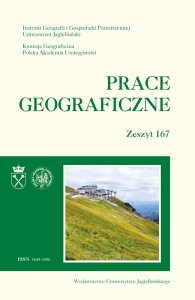Zrównoważony rozwój w ujęciu lokalnym – analiza wymiarów
Local perspective of sustainable development – analysis of the dimensions
Author(s): Dorota Dymek, Jolanta JóźwikSubject(s): Environmental Geography, Rural and urban sociology
Published by: Wydawnictwo Uniwersytetu Jagiellońskiego
Keywords: sustainable development; TOPSIS; rural and urban-rural communes; protected areas;
Summary/Abstract: The idea of sustainable development is recognised as a basic concept for the development of communes. Its essence is based on the balance and sustainability of its three basic dimensions, namely social, economic and environmental. From the point of view of shaping the further development of territorial units, it therefore seems important to examine possible imbalances between the various dimensions, since it is recognised that sustainable development can only be achieved if there is a balance between them. The aim of the article is to identify the dominant dimension of sustainable development in rural and urban-rural communes in Poland. Special emphasis was placed on presenting differences in the distribution of these dimensions between units with a high share of protected areas (at least 50% of the area) and other units. The level of development of communes in individual dimensions was determined using the TOPSIS method based on statistical data made available in the CSO Local Data Bank for 2019. The analysis showed that there were disproportions in the level of development of communes in individual dimensions and in the spatial distribution of the dominant dimensions. Large differences were observed between the eastern and western parts of the country. Throughout Poland, the environmental dimension most often prevailed, followed by the economic dimension and least often by the social dimension. In the case of communes with a high share of protected areas, it was the environmental dimension, while in the case of the rest of the communes, it was the economic dimension. The study also showed a low correlation between the level of development of the communes in the economic dimension and the share of protected areas. However, there was no linear relationship between the share of protected areas and the level of development of the communes in other dimensions.
Journal: Prace Geograficzne
- Issue Year: 2022
- Issue No: 167
- Page Range: 29-48
- Page Count: 20
- Language: Polish

